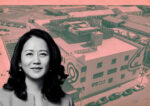Trending
Miami’s life science research area blossoms

In a commercial building in Miami’s historic Overtown neighborhood, one tenant harvests bone for dental implants, another tests a lab theory that Chinese moths can treat epilepsy while a third uses expensive bandwidth to link U.S. clinics around the world live with specialists at the hospitals and universities in Miami’s 153-acre medical district.
Although new Miami has come to be known for art hubs Wynwood and the Design District, Overtown, a historically black neighborhood off the interstate, has a blossoming biomedical industry.
The 250,000-square-foot — 68 acres — University of Miami Life Science Technology Park is nestled among six hospitals and over 3,500 beds, and contains the nation’s largest tissue bank.
In Miami, which has the second-largest medical district in the U.S. behind Houston, Tex., medicine has clearly become big business. The district employs as many as 100,000 people, though not all in high-paying jobs.
The park’s developer, Wexford Science and Technology, a biomedical realty company, has developed similar multi-use medical spaces around the U.S., including the University Technology Park at IIT, the Hershey Center for Applied Research and a 100,000-square-foot wet and dry lab at Norfolk, Va.’s Old Dominion University.
Miami’s Life Science Technology Park is 75 percent leased. Its tenants are a mix of university research facilities and medical companies at different stages, sharing labs and expensive glasswash equipment, and protected from natural disaster with hurricane-grade construction and a power generator. The space, anchored by the University of Miami’s 80,000-square-foot tissue bank, is becoming a center for commercial biomedicine, a growth area in Miami, according to Bill Hunter, a developer at Wexford. The building is within walking distance of UM’s medical school and stem cell institute.
“We’re making a market down here,” Hunter told The Real Deal. “It’s the halo effect, it’s going to spread out and create more tech start-ups,” he said.
Kidney specialist company DaVita just inked a 20,000-square-foot lease. It will collaborate with the university, using members of the Division of Interventional Nephrology to collect and analyze patient data for studies related to kidney diseases and other illnesses.
“We have one of the most diverse populations in the world – a melting pot of melting pots. It’s a doctor’s dream,” said Hunter.
UM’s tissue bank is the building’s largest tenant and one of the site’s major draws. UM has a separate brain endowment bank, and many of the building’s other users center around harvesting tissue for research and use, Hunter said. International and early-stage companies include university spin-offs, like Cirle, a spin-off from Dr. Richard Awdeh’s work at the University of Miami-affiliated Bascom Palmer Eye Institute.
The biggest ground-floor tenant of the Life Sciences building is the Miami Innovation Center, an open, 40,800-square-foot space, and the headquarters of Project LIFT, a business “accelorator” where young companies spend a several-month stint in a co-working environment, learning marketing and branding tips and meeting potential investors and partners.
Ali Khoshnevis, one of the Project LIFT participants, invented software that allows patients to compare the price of pharmaceuticals in their neighborhoods.
“For example, the generic of Lipitor can cost anywhere from $11 to $150,” Khoshnevis said, whose company, WeRx, has a fully developed program as a downloadable application in The App Store and is focused on marketing.
Crystal Ice is the top executive of AlertMD, another tech-based company, that allows users to sign up for a smartphone app that aggregates their medical history, assigning each person a code that can be read in the case of a medical emergency.
The company came down to Miami from West Palm Beach a month ago to prepare for the launch of its pilot program later this month. It may not have to go far to find clients.
“A woman was brought in and she wasn’t identified for days and days. All she had with her was a Smartphone, but it was locked. You only have 24 hours to harvest organs,” Ice said.




